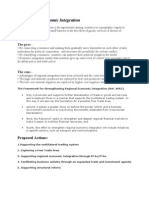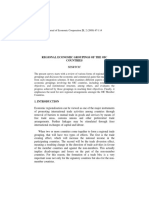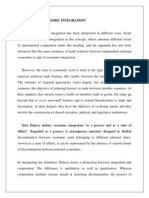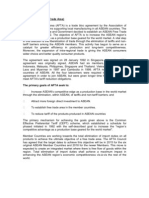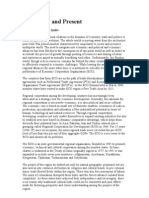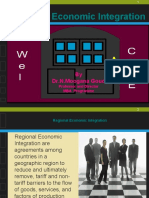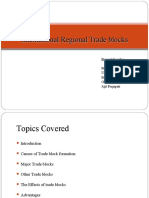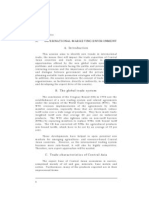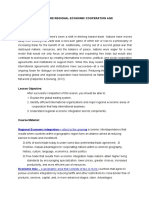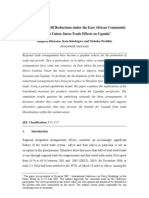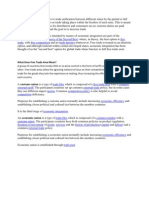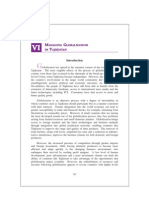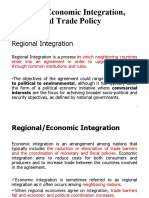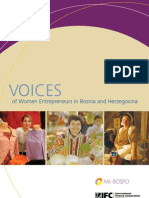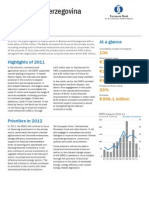7 - tr12d
7 - tr12d
Uploaded by
api-198396065Copyright:
Available Formats
7 - tr12d
7 - tr12d
Uploaded by
api-198396065Copyright
Available Formats
Share this document
Did you find this document useful?
Is this content inappropriate?
Copyright:
Available Formats
7 - tr12d
7 - tr12d
Uploaded by
api-198396065Copyright:
Available Formats
62
Regional tRade integRation and euRasian economic union
Chapter 4
Regional economic integration has the potential to bring multiple economic benefits through trade creation, the facilitation of exports to the rest of the world, more efficient markets and the opportunity to build stronger economic institutions. to reap these benefits, the key challenges are to lower non-tariff barriers to trade, to improve cross-border infrastructure, limit the use of tariff barriers with other countries, extend liberalised market access to service sectors and strengthen institutions at the level of regional governance.
63
at a glance
the FACtS
25-100 %
estimated increase in trade flows due to improvements in cross-border infrastructure
% 70%
around
Overall increase in trade among Customs Union members between 2009 and 2011
12% 12%
Share of firms in regions bordering Kazakhstan and Belarus which view customs and trade regulations as a major or very severe obstacle, compared with 31 per cent of firms in regions bordering other countries
25%
less than
Share of goods that are exported only within the Customs Union
Chapter 4 transition Report 2012
64
RegionAl tRAde integRAtion And euRASiAn eConomiC union
At the start of transition over 20 years ago many old economic ties within and between countries in the former communist bloc were severed. Initial centrifugal forces quickly gave way to regional integration initiatives, both among transition countries themselves and with new trading partners in the West. Between 1992 and 2007 most countries in central Europe and the Baltic states (CEB) and south-eastern Europe joined the Central European Free Trade Agreement (CEFTA) and 10 later joined the European Union. (Croatia will do so in 2013.) The latest development in regional economic integration, and the first successful attempt involving constituent countries of the former Soviet Union, is the creation, within the Eurasian Economic Community,1 of a Customs Union and Common Economic Space by Belarus, Kazakhstan and Russia and of new supranational institutions, including a Eurasian Economic Commission. Based on the early evidence, this chapter assesses what the new Customs Union has achieved to date and what it could potentially accomplish in the future. It considers whether a common tariff policy is having any measurable impact, whether the Union is lowering non-tariff trade barriers and also what the potential effects on trade might be of reducing barriers further. It also examines whether regional economic integration can help to promote member countries exports and contribute to better economic institutions, drawing additionally on experiences of trade integration elsewhere in the world.
Box 4.1 Comparative advantage through regional integration the case of ASEAN The ASEAN Free Trade Area (AFTA) is a trade bloc agreement set up by the Association of Southeast Asian Nations to increase their export competitiveness. It was originally signed in 1992 by six countries Brunei, Indonesia, Malaysia, Philippines, Singapore and Thailand and subsequently by Vietnam in 1995, Laos and Myanmar in 1997 and Cambodia in 1999. AFTAs primary mechanism is the Common Effective Preferential Tariff (CEPT), which caps tariffs for goods originating within ASEAN to between 0 and 5 per cent. Unlike the European Union, AFTA does not apply a common external tariff to goods imported from outside the region. ASEANs vision was to leverage intra-regional division of labour and specialisation to encourage exports to the rest of the world by eliminating tariff and non-tariff barriers to movement of goods along the supply chain within the region. Using regional integration as a springboard for export growth is sometimes referred to as the flying geese paradigm.3 The metaphor derives from the idea that the less-developed nations, with lower labour costs, can be aligned successively in a wild-geeseflying pattern behind the advanced industrial nations according to their different stages of development. As the comparative advantages of the lead goose cause it to shed its labour-intensive production in favour of more capital-intensive activities, the low-productivity function is transferred further down the chain to upper-middle-income countries, then lower-middle-income countries and so on. Foreign direct investment and multinational corporations (MNCs) meanwhile facilitate the transfer of technologies among member states.4 Within ASEAN, Singapore emerged as the lead goose intermediating a large share of trade between the region and the rest of the world. Regional integration was essentially led by industries such as electrical and electronic products and industrial machinery. These industries developed a high degree of vertical specialisation, where intermediate components and semi-finished products were traded within the ASEAN region and final products were exported to the rest of the world. Intermediate goods account for as much as 40 per cent of intra-ASEAN trade, while dependence on Japan as a source of intermediate inputs has declined sharply.5 This model has helped the ASEAN countries to leverage the substantial existing differences in per capita income and skills and achieve dynamic growth in the region as a whole.6
Customs union and Common eConomiC spaCe: an overview
The idea of a deeper regional economic integration within the Commonwealth of Independent States (CIS) is not new. It was put forward in the early 1990s by a number of economists, and the term Eurasian Economic Community was coined by Nursultan Nazarbayev, the President of Kazakhstan, in March 1994. However, progress towards integration has been slow; although an agreement to create a CIS free trade area was reached in principle in 1994, an actual free trade agreement was only signed 17 years later. The integration process gained political momentum in November 2009 when Belarus, Kazakhstan and Russia signed an agreement establishing a Customs Union and started applying a common import tariff from 1 January 2010.2 Internal border controls were removed, first between Belarus and Russia and then between Kazakhstan and Russia. Under the Customs Union framework, import tariff revenues accrue to national budgets in predetermined proportions (with Russia
40%
3 4
share of intermediate goods in trade within asean
The Eurasian Economic Community includes Belarus, Kazakhstan, the Kyrgyz Republic, Russia and Tajikistan. For a small number of products (including cars for personal use and pharmaceuticals) special transition arrangements have been agreed for Belarus and Kazakhstan.
The paradigm was originally developed in the 1930s and is best summarised in Akamatsu (1962). It originally referred to the economic integration in east Asia and the role of Japan. See Menon (1996) for a discussion of the role of MNCs. 5 See Fujita (2001). 6 See Ng and Yeats (1999).
Chapter 4 Regional trade integration and eurasian economic union
65
entitled to 88 per cent, Kazakhstan to 7 per cent and Belarus to 5 per cent, but subject to regular review). The Union is open to other countries provided that they share a common border with the existing members. Within the CIS, this stipulation currently precludes Armenia, Moldova and Tajikistan, but the Kyrgyz Republic is considering membership and Ukraine has been invited to join. The next stage was launched on 1 January 2012 with the creation by Belarus, Kazakhstan and Russia of the Common Economic Space of the Eurasian Economic Community. It involves developing supranational institutions, modelled explicitly or implicitly on those of the European Union, headed by the Eurasian Economic Commission, with nine commissioners responsible for various areas of economic integration. The Commission is expected to gradually assume some of the competencies of national authorities, including import tariff-setting (previously delegated to its predecessor, the Customs Union Commission), technical regulations and competition policy. Key decisions within this supranational framework will be taken by the Council of Country Representatives based on the one country-one vote principle. In some cases decisions require unanimous approval. The decisions of the supranational bodies become legally binding for member countries a certain period after their publication and will prevail over any inconsistent national norms. Any disputes can be taken to the Economic Court of the Eurasian Economic Community, the decisions of which are binding on member states. The Eurasian Development Bank, based in Almaty in Kazakhstan, has a broader membership beyond the Customs Union countries and includes Armenia, the Kyrgyz Republic and Tajikistan. The Bank currently has an Anti-Crisis Fund (ACF) programme to help Belarus (subject to policy conditions and regular reviews), under which two disbursements totalling US$ 1.24 billion were made in 2011. Tajikistan is also a beneficiary of a US$ 70 million ACF programme. The ultimate goal of the Eurasian Economic Community is free movement of goods, capital and people, as well as the harmonisation of macroeconomic and structural policies. As of 2012 the member countries agreed to codify various existing agreements and treaties by 2015 and then discuss steps towards further integration.
Regional economic integration can bring multiple benefits. First, lower tariff and non-tariff trade barriers should increase trade and enhance consumer choice. In the case of the Eurasian Customs Union, the immediate trade creation effects would mainly reflect the elimination of administrative barriers as customs checks are removed from internal borders (since most trade between the member countries was already subject to zero customs duties). Improvements in cross-border regional infrastructure might also play an important role.
regional trade integration: benefits and Challenges
Second, producers within a regional integration grouping can benefit from increased market size. Market size, in turn, is an important factor facilitating innovation, the fixed costs of which can be spread across a larger customer base.7 At the same time, consumers will also benefit from greater competition in product markets. These effects crucially depend not just on the creation of a single customs area, but also on the elimination of barriers to market access. Important progress has been made in this respect in Belarus, Kazakhstan and Russia where, with a few exceptions, firms have equal access to public procurement contracts in all three countries. Third, exporting within a regional area may serve as a first step towards the expansion of exports worldwide by initially building export capacity taking advantage of low tariff and nontariff barriers within a union, and then leveraging this capability to achieve competitive advantage in exporting to other countries. For Kazakhstan and Russia, developing such export capability is a particularly challenging task given their existing relatively narrow, natural resource-focused export bases.8 Fourth, countries within a regional integration area can build cross-border production chains by leveraging each others comparative advantages and subsequently exporting the finished product outside that area (see Box 4.1 for an example of such integration in the Association of Southeast Asian Nations). Links through foreign direct investment (FDI) typically play a prominent role in this scenario, as they did in the 1990s when CEB countries became increasingly integrated in European production chains. Fifth, deeper regional economic integration can help member countries to strengthen their economic and political institutions. As some competencies are delegated to newly created supranational bodies, and other areas of economic policy undergo cross-country synchronisation, the opportunity arises to review and revise laws and regulations and to strengthen their implementation, in turn promoting business environment improvement and liberalisation. Accession to the European Union undoubtedly played a key role in enhancing institutions in the CEB countries, and the longer-term viability of CIS regional integration will depend largely on whether the Eurasian Economic Community can create institutions stronger than those of any of its member states. Lastly, integration can encourage the liberalisation of services markets, which tend to be subject to greater regulation and protection compared with those for goods (and even within the European Union they remain fragmented to some extent). Nevertheless, in the context of Eurasian integration there is great potential for efficiency gains in these markets which could be realised by lowering entry barriers for firms and investors from other countries.9 Regional economic integration also comes with a number of challenges, the most important of which is to minimise negative effects on economic links with outside countries. Such effects typically occur through trade diversion, whereby a relative change
7 8 9
See EBRD (2010) for a discussion of the relationship between exports and innovation. See EBRD (2008) and EBRD (2012). See, for instance, Jensen et al. (2007) and Tarr and Volchkova (2010) in the context of Russia.
Chapter 4 transition Report 2012
66
Box 4.2 Asymmetries in regional trade integration the case of Mercosur Mercosur is an economic and political agreement among Argentina, Brazil, Paraguay, Uruguay and Venezuela. Founded in 1991 under the Treaty of Asuncin, which was later amended and updated by the 1994 Treaty of Ouro Preto, it is a full customs union, which represents a significant stage in Latin American integration. As with the Customs Union of Belarus, Kazakhstan and Russia, Mercosur members are very different in terms of their economic size. Brazil accounts for over 70 per cent of the regions population, territory and GDP, while Uruguay and Paraguay each account for less than 5 per cent. However, Brazil is not richer in income per capita terms than Argentina or Uruguay, and in fact includes Mercosurs poorest regions. Given these disparities, Mercosur members have sometimes found it difficult to agree on common policies. The common external tariff (CET) is the cornerstone of the common trade policy, but only covers around 80 per cent of products. Further convergence has perhaps been hampered by the fact that the CET is often perceived as favouring Brazilian interests ahead of those of the smaller members.10 The common tariff varies between 0 and 20 per cent, with higher tariffs levied on final consumption goods.11 Many exemptions for smaller countries still remain, especially those covering capital goods and computing and telecommunication equipment, as do exceptions under bilateral trade agreements. Furthermore, member-state policies on investment, export promotion and anti-dumping protection are not necessarily coordinated. Despite these difficulties, Mercosur appears to have had regional benefits. In particular, there is evidence that it has promoted, rather than impeded, trade with countries outside the region. For a number of industries, including automotive manufacturing, certain petrochemicals and plastics, Mercosur has served as an initial platform for Argentine and Brazilian exporters, enabling them to further improve their productive capacity and organisation and to promote their goods to the rest of the world. Although the smaller member countries of Mercosur have more open and specialised economies, a substantial proportion of their total trade remains within the bloc as the other members represent a relatively large market for their products.
in tariff barriers can divert trade from more efficient external exporters to less efficient ones.12 For example, should the introduction of a common external tariff by a regional bloc result in a relative increase in the import tariff for country A outside the region compared with that for country B inside the region, one would expect an increase in imports from country B and a drop in imports from country A. As a result, however, consumers must buy goods from the less efficient producer. Concerns about trade diversion have been raised in the context of the Eurasian Customs Union. Its common tariff, which was formulated in the crisis environment of 2009, was also used in part as a tool of industrial policy to promote selected import substitution through an increase in tariffs (for example, in the case of the automotive sector). The common tariffs introduction resulted in significant changes to the import tariff structure in each constituent country, with tariff lines adjusted upwards and downwards. Kazakhstans schedule underwent the most extensive changes, affecting more than 50 per cent of tariff lines (see Chart 4.1) and mostly in an upward direction. The empirical impact of these changes is examined in the next section. Another concern, and particularly in relation to the Eurasian bloc, is asymmetry. The disparity in the economic size of the largest state, Russia, and that of the other members is perhaps greater than in any other regional economic grouping. Kazakhstans population and gross domestic product (GDP) are around one-tenth of those of Russia, and those of Belarus are lower still. While comparisons with other integration ventures which include dominant countries (for example, Brazil in Mercosur see Box 4.2) suggest that the benefits of regional integration are still substantial, asymmetries can become an obstacle. It is important to ensure that the decisions
Chart 4.1 Change in import tariffs in Kazakhstan
Percentage points
20 15 10 5 0 -5 Furniture Wood and cork Non-metal minerals Other transport equipment Basic metals Forestry Publishing Motor vehicles Electrical machinery Machinery Rubber and plastics Oce equipment Agriculture Chemicals Petroleum Total Pulp Coke Medical Coal Tobacco Food and beverages Other mining Metal ores Radio Finishing Apparel Leather Textiles Fabricated metals Electricity
Source: World Bank (2011). Note: This chart depicts the change in the average eective tari rate at the industry level before and after the Customs Union came into force, inclusive of transitional provisions. Total refers to an overall average.
10
11
See Olarreaga and Soloaga (1998). See also Laursen (2010) for a discussion of political aspects of integration. See Kume and Piani (2001).
12
The term trade diversion was coined by Viner (1950). See Venables (2003) for a detailed discussion of the issue.
Chapter 4 Regional trade integration and eurasian economic union
67
Box 4.3 A union of commodity exporters the case of the Gulf Cooperation Council The Gulf Cooperation Council (GCC), formed in 1981, is the political and economic union of Bahrain, Kuwait, Oman, Qatar, Saudi Arabia and the United Arab Emirates (UAE). Much like the Eurasian Customs Union and Mercosur, it is characterised by a significant asymmetry between Saudi Arabia, the largest state, and the other members. Saudi Arabia has about 70 per cent of the total GCC population and accounts for more than half of total GCC GDP, while the UAE, the next largest, produces roughly 20 per cent of GDP. However, Saudi Arabias income per capita is lower than that of most of the other countries. An interesting feature of the GCC is its members common reliance on oil and gas exports, mainly to Asia and the United States. For example, hydrocarbons account for over 90 per cent of the total exports of Saudi Arabia. As a result, intra-regional trade remains fairly limited; only Oman sends more than 10 per cent of its total exports to other GCC members. Also, although Oman imports machinery from the UAE and Bahrain imports oil and fuel products from Saudi Arabia, other GCC countries source less than 15 per cent of their imports from within the grouping. This heavy reliance on oil and gas exports has shaped the evolution of the GCC and some of its unique features. The GCC has a high degree of infrastructure integration, including a unified pipeline network to distribute natural gas among the six member states, an integrated railway system and a unified power grid. It has also created a common market, launched at the start of 2008 to allow the unrestricted movement of goods, capital and labour. As a result, there has been a marked increase in cross-border investment, often involving mergers and acquisitions (M&A) and targeted largely at the service sector (notably telecommunications). Since December 2010 companies based in one GCC country have been able to set up branches in other member states. The distribution of cross-border direct investment has been fairly balanced, with Kuwait among the key sources and also key recipients of M&A flows. However, the implementation of a customs union, first announced in 2003, has been postponed until at least 2013. Also, labour mobility has been slow to expand despite the fact that the common market grants the same economic rights to all GCC citizens, allowing them to work in the private and public sectors in each member state and to receive any applicable welfare benefits such as pension and social security payments. By 2010 only around 21,000 nationals (around 0.05 per cent of the total population) had taken up permanent employment in a GCC state other than their country of origin. All GCC economies nevertheless remain important employers of foreign labour due to a perceived shortage of manpower in the region. Overall, given the limitations of trade links among these major oil and gas exporters in the short term, economic integration in the GCC has focused on common infrastructure, investment flows and liberalisation of mutual access to services markets. Over time, the structure of its constituent economies, and the GCC itself, may evolve as the natural resource endowments of the member states run out at different rates. At current production levels, oil reserves will last for less than two decades in Bahrain and Oman, but for more than 100 years in Kuwait and the UAE.
of supranational bodies are implemented by all member countries, and that dispute resolution mechanisms at the supranational level work well. In a regional union dominated by commodity exporters, a further challenge is to leverage the benefits of economic integration. Partly due to the fact that Kazakhstan and Russia predominantly export oil and other commodities, the Customs Union is less economically integrated than commonly perceived: Belarus and Kazakhstan account for under 7 per cent of Russias export and import trade, although Belarus, as a net energy importer, sources over half of its total imports from Kazakhstan and Russia. The Gulf Cooperation Council (GCC) is a similar example of a regional economic union dominated by major oil exporters (see Box 4.3). Regional integration does present substantial challenges in the case of outward-oriented commodity exporters (not least the challenge of harmonising approaches to taxation of commodity exports). Nevertheless, these countries can still benefit from cooperation in many areas, including the development of cross-border
infrastructure, cross-border investment and the liberalisation of mutual access to services markets. Lastly, while deeper economic integration may yield substantial benefits, it can also aggravate the macroeconomic vulnerabilities of member states. As production chains become more integrated, shocks to world trade (such as that in 2008) permeate quickly through regional economic blocs. Producers of intermediary goods may be particularly badly affected as suppliers of final goods cut orders and run down their existing stocks of input materials.13 As a result, output contractions can be amplified through close trade linkages and so affect the strength of subsequent recovery.
13
See Zavacka (2012) for a discussion of this so-called bullwhip effect.
Chapter 4 transition Report 2012
68
Table 4.1 Changes in imports
Kazakhstan dependent variable: change in imports change in tariffs change in bilateral imports, 2006-08 change in bilateral imports, 2008-09 Bilateral imports, 2009, log change in world imports, 2006-08 change in world imports, 2008-09 World imports, 2009, log constant number of observations R-squared number of industry fixed effects Source: Authors calculations. Note: The table shows the results of ordinary least squares regressions of changes in imports in 2009-10 (in logarithmic terms). Robust standard errors in parentheses. Values significant at the 10 per cent level are marked with *; at the 5 per cent level with **; at the 1 per cent level with ***. A negative coefficient for the change in tariffs means that imports decreased in response to a higher tariff or that tariff increased in response to a lower import tariff. World
0.0024 (0.0028)
Belarus China
-0.0141** (0.0071) -0.1514*** (0.0447) -0.4621*** (0.0877) -0.1569*** (0.0429) -0.0153 (0.0752) 0.1664 (0.1116)
Russia China
-0.0078 (0.0132) 0.0771 (0.0491) -0.0424 (0.148) -0.1469** (0.0599) -0.0581 (0.0964) -0.1143 (0.1974)
CU
0.0076* (0.0039) 0.0068 (0.0372) -0.2622*** (0.0507) -0.1267*** (0.0217)
EU
-0.0056 (0.0049) -0.0556 (0.0459) -0.3146*** (0.0675) -0.1495*** (0.0284) 0.0479 (0.0662) -0.2468*** (0.0907)
CIS
0.0009 (0.0136) 0.0101 (0.0579) -0.3133** (0.1275) -0.3110*** (0.0753) -0.2297** (0.1010) -0.1135 (0.1837)
World
-0.0133*** (0.0032)
CU
0.0077 (0.006) 0.1102*** (0.0423) -0.3940*** (0.0594) -0.0452** (0.0191)
EU
-0.0233*** (0.0049) -0.0033 (0.036) -0.3118*** (0.0688) -0.1012*** (0.0208) -0.0931* (0.0483) -0.1654** (0.0819)
CIS
-0.0015 (0.013) -0.0028 (0.0548) -0.3606*** (0.0916) -0.033 (0.0477) -0.0145 (0.1061) 0.1658 (0.1411)
World
-0.0114*** (0.0032)
CU
0.0026 (0.0084) 0.0243 (0.023) -0.1474*** (0.053) -0.0567*** (0.0196)
EU
-0.0099** (0.0039) -0.0721*** (0.0258) -0.3024*** (0.0338) -0.0606*** (0.0082) 0.0112 (0.0319) 0.0462 (0.0376)
China
-0.0128** (0.0051) -0.0495*** (0.0183) -0.2980*** (0.032) -0.0499*** (0.012) 0.0562 (0.0342) 0.1983*** (0.0453)
CIS
-0.0061 (0.012) 0.0553 (0.036) -0.2346*** (0.0531) -0.0807*** (0.0217) -0.0166 (0.053) -0.0564 (0.0713)
-0.1020*** (0.0198) -0.3218*** (0.0294) -0.1111*** (0.0129) 0.7099*** (0.1159) 1,323 0.1760 133
-0.0330 (0.0509) 0.0690 (0.0620)
-0.0195 (0.0163) -0.3655*** (0.0263) -0.0500*** (0.0104)
-0.1110** (0.0536) 0.0394 (0.0759)
-0.0651*** (0.0128) -0.2625*** (0.0174) -0.0446*** (0.006)
0.0143 (0.0479) -0.1473*** (0.0542)
0.3902** (0.1978) 486 0.1821 99
0.9338*** (0.2460) 542 0.2995 93
1.5044*** (0.3662) 295 0.2221 77
2.4767*** (0.6562) 156 0.3393 55
0.4791*** (0.0891) 1,578 0.1605 147
0.4085** (0.1605) 640 0.1795 109
0.8852*** (0.1736) 747 0.257 119
1.3077*** (0.4675) 143 0.1138 55
0.3447 (0.3884) 187 0.1374 66
0.6569*** (0.0581) 2,917 0.109 162
0.5253*** (0.1731) 508 0.0726 109
0.7264*** (0.0776) 2,084 0.1293 151
0.8743*** (0.1064) 1,250 0.1061 136
0.8454*** (0.1959) 460 0.145 106
Chart 4.2 Customs Union import volumes by trade partner
US$ billion
400 350 300 250 200 150 100 50 0 2006 2007 2008 2009 2010 2011
It is too soon to judge to what extent multiple benefits of regional integration within the Eurasian Economic Community may materialise, and whether the numerous challenges and risks can, respectively, be overcome and minimised. Nonetheless, it is useful to see what can be learned from the early evidence. In 2010-11 intra-regional trade between Belarus, Kazakhstan and Russia increased by over two-thirds, and in the first five months of 2012 it continued to expand at the rate of 15.5 per cent year-on-year. Was this impressive growth a reflection of deeper economic integration or merely in line with global trends in the post-crisis recovery of trade? In the wake of the 2008-09 crisis, overall imports into this Eurasian bloc contracted by 35 per cent (see Chart 4.2) and imports from within it similarly fell by over one-third. However, in 2010 imports started to recover, increasing by 31 per cent overall. This recovery was strongest for goods from China and the
assessment
mARket ACCeSS And tRAde CReAtion
Customs Union EU-27 China CIS (excl. CU) Others Source: Kazstat, Rosstat, Belstat and Customs Union Commission. Note: CU is the Customs Union of Belarus, Kazakhstan and Russia, EU-27 are the 27 current members of the European Union.
Hungary
Bulgaria
Armenia
Georgia
Ukraine
Turkey
Kyrgyz Rep.
Poland
Croatia
Slovenia
Tunisia
Estonia
Morocco
Russia
Kazakhstan
Slovak Rep.
Lithuania
Romania
Jordan
Latvia
Egypt
Chapter 4 Regional trade integration and eurasian economic union
69
CIS countries followed by goods from within the new Customs Union, although some trade volumes (for example, Kazakhstans imports from the European Union) continued shrinking. In 2011 the recovery was maintained and imports from within the Customs Union surpassed the level of 2008 in nominal terms (by 12 per cent). The trends were similar for exports. To gauge the magnitude of trade recovery effects, trade creation within and outside the Customs Union and trade diversion effects (if any), the highly disaggregated structure of exports and imports of each country can be examined. At the six-digit level of the Harmonized System (HS) classification, goods are divided into over 5,000 separate lines (such as bottles for sterilisation or washing machines, for instance). Changes in trade flows between various trading partners following the introduction of the Customs Union can be analysed by comparing the sectors where tariffs were revised and those where they were not.14 Chart 4.3 shows the distribution of tariff changes for different countries. As previously mentioned, in the case of Kazakhstan more than 50 per cent of tariff lines for non-CIS countries have been revised, and predominantly upwards (while CIS countries have retained a largely duty-free regime based on various bilateral treaties). In Belarus and Russia fewer tariff lines underwent changes and more six-digit tariff lines saw reductions rather than increases (in non-weighted terms). This is also consistent with the change in overall effective import tariff rates, calculated as the ratio of all import duties collected to all imports in a given year. For example, in Russia this ratio declined from an average of 9.1 per cent in 2006-09 to 8.6 per cent in 2010-11.15 Table 4.1 shows the results of a statistical analysis, undertaken separately for each member of the Customs Union, that seeks to explain changes in imports of a given product from a particular region (meaning other Union members, China, CIS countries outside the Union, the European Union or the world as a whole) in terms of past variations in import levels as well as changes in effective tariff rates since the start of the Customs Union.16 The regression analysis confirms that changes in volumes of imports between 2009 and 2010 were largely driven by trade recovery effects. For the world as a whole, a 10 per cent decline in imports during 2009 was associated with an approximately 3 per cent increase the following year in all three countries. The same was true for trade with individual partners.17 Collapses in trade during crises are indeed known to overshoot by far the contraction of demand, tending to herald a subsequent brisk recovery.18 Moreover, as trade in intermediate goods tends to be affected more than trade in final goods, some trade partnerships may be affected much more than others. Imports also exhibited market saturation properties: the higher the pre-Customs Union import level of a given type of product from a given partner, the slower the growth in imports. The first row of coefficients in Table 4.1 reveals that changes in tariffs per se did not have a significant impact on the aggregate (world) import flows in Kazakhstan, at least in the short term. However, they did have some effect on trade
Chart 4.3a Distribution of changes in tariffs on Customs Union's introduction Kazakhstan
% of affected tariff lines
60 50 40 30 20 10 0 -20 and below -20 to -10 -10 to -5 -5 to 0 0 0 to 5 5 to 10 10 to 20 20 and above
Source: National authorities, International Trade Centre, Customs Union Commission and authors calculations. Note: Distribution densities shown relate to non-trade-weighted changes in taris before and after the Customs Union came into force at the six-digit level of disaggregation, excluding transitional provisions Chart 4.3b and lines with no recorded imports. For intervals reported on the horizontal axis the lower bound is Distribution of changes Both bounds are excluded in the 0 to included and the upper bound is excluded. in tariffs on Customs5 category.
Union's introduction Belarus
% of affected tariff lines
80 70 60 50 40 30 20 10 0 -20 and below -20 to -10 -10 to -5 -5 to 0
0 to 5
5 to 10
10 to 20
20 and above
Source: National authorities, International Trade Centre, Customs Union Commission and authors calculations. Note: Distribution densities shown relate to non-trade-weighted changes in taris before and after the Customs Union came into force at the six-digit level of disaggregation, excluding transitional provisions Chart 4.3c and lines with no recorded imports. For intervals reported on the horizontal axis the lower bound is Distribution of changes Both bounds are excluded in the 0 to included and the upper bound is excluded. in tariffs on Customs5 category.
Union's introduction Russia
% of affected tariff lines
80 70 60 50 40 30 20 10 0 -20 and below -20 to -10 -10 to -5 -5 to 0
0 to 5
5 to 10
10 to 20
20 and above
Source: National authorities, International Trade Centre, Customs Union Commission and authors calculations. Note: Distribution densities shown relate to non-trade-weighted changes in taris before and after the Customs Union came into force at the six-digit level of disaggregation, excluding transitional provisions and lines with no recorded imports. For intervals reported on the horizontal axis the lower bound is included and the upper bound is excluded. Both bounds are excluded in the 0 to 5 category.
Trade flows are expressed in US dollar terms. Calculated using data from the Central Bank of Russia and the Russian Treasury taking into account all import duties and fees collected in Russia, including those subsequently transferred to the Treasuries of Belarus and Kazakhstan. 16 See Isakova and Plekhanov (2012) for further discussion. Analysis excludes product lines for which exclusions from the common external tariff apply or trade volumes are less than US$ 1 million. 17 Results for the rest of the world (not reported) are similar.
14 15
18
See Baldwin (2009).
Chapter 4 transition Report 2012
70
with individual partners. In particular, increases in tariffs had a statistically significant negative impact on imports from China. The coefficients imply that a 2 percentage point tariff increase (the average for the sample) led to a 2-3 per cent contraction in imports of respective goods from China. A similar increase in tariffs also led to a 1-2 per cent increase in imports from within the Customs Union.19 Imports from the European Union, CIS and the rest of the world were broadly unchanged. The coefficients for changes in tariffs may in fact combine two effects. For increases in tariffs, which were more common in Kazakhstan, a negative coefficient means that trade declined in response to higher tariffs. At the same time, in cases where tariffs were reduced, the same negative coefficient reflects an increase in trade in response to the tariff reduction. It is therefore useful to check for asymmetries in the response of import flows to increases and reductions in tariffs (see Table 4.2). It turns out that in Kazakhstan significant changes in trade flows were only observed in response to increases in tariffs. This means that the positive relationship observed in Tables 4.1 and 4.2 between changes in tariffs and changes in imports from Customs Union countries reflects a trade diversion effect. For example, imports into Kazakhstan from Russia may have increased because imports from China became more expensive following the introduction of a higher common external tariff by the Customs Union members. In the case of Belarus, Table 4.1 indicates that tariff changes had a significant negative impact on overall (world) import flows. Unlike Kazakhstan, however, the positive effect on imports from the Customs Union was small and statistically insignificant. This is possibly explained by the fact that tariff changes were much less drastic for Belarus, which already had a tariff structure similar to that of Russia. At the same time, tariffs had a small but statistically significant negative impact on trade with the European Union.
Again, this raises the question of whether these negative coefficients should be interpreted as reflecting trade creation or trade diversion. Table 4.2 suggests that, as in the case of Kazakhstan, significant responses in trade flows were observed only in response to increases in tariffs. A 0.5 percentage point tariff increase (the average for the sample) was associated with a 2-3 per cent reduction in imports from the European Union and a 1-2 per cent reduction in respective imports from the world as a whole.20 The Table 4.1 results for changes in import flows in Russia appear to be similar to those for Belarus. However, Table 4.2 suggests that imports into Russia from the world as a whole, and from the European Union in particular appear to have responded to reductions rather than increases in tariffs. Trade with China and the rest of the world appears to have responded both to increases and reductions in tariffs. The greatest of these effects is apparent for imports from China, where a 2 per cent fall in tariffs (the sample average) led to a 2-3 per cent increase in imports. The overall finding of this analysis is that changes in tariff policy have to date had a fairly limited impact on trade flows to members of the Customs Union. Tariff-related increases in imports from within the Union were particularly small and statistically significant for Kazakhstan alone, where it appears to be a result of higher external tariffs in relation to non-Union countries. In addition, tariff increases have had statistically significant negative effects on trade between Customs Union members and selected trade partners. These effects were most pronounced for trade with China, and to a lesser extent with the European Union. This indicates some degree of trade diversion. To date, the Customs Union appears to have had tariff-related trade creation effects only for Russia, as reductions in external tariffs have been associated with higher imports from selected trade partners outside the Union.
Chart 4.4a Percentage of rms viewing cross-border trade regulations and customs as serious obstacles
%
35 30 25 20 15 10 5 0 Customs Union Other CIS countries South-eastern Europe EU-10
Chart 4.4b Percentage of Russian rms viewing cross-border trade regulations and customs as serious obstacles
%
35 30 25 20 15 10 5 0 Regions bordering Belarus or Kazakhstan Non-border regions Other border regions
Very severe obstacle Major obstacle Source: BEEPS Survey and authors calculations. Note: Based on 2008-09 data.
Very severe obstacle Major obstacle Source: BEEPS Survey and authors calculations. Note: Based on preliminary data.
19
Customs Union estimates for Kazakhstan are based on preliminary incomplete data. See Isakova and Plekhanov (2012) for details.
Georgia Hungary Ukraine Bulgaria Turkey Armenia Kyrgyz Rep. Jordan Croatia Slovenia Poland Tunisia Estonia Morocco Russia Latvia Egypt Kazakhstan Slovak Rep. Lithuania Romania
20
This result is driven by a relatively small number of product lines for which the tariffs increased: 59 for the world as a whole and 29 for the European Union, predominantly in the food, automotive and construction materials sectors.
Hungary Bulgaria Armenia Georgia Ukraine Turkey Kyrgyz Rep. Croatia Slovenia Poland Tunisia Estonia Morocco Russia Kazakhstan Slovak Rep. Lithuania Romania Jordan Latvia Egypt
Chapter 4 Regional trade integration and eurasian economic union
71
Importantly, this analysis may underestimate the eventual trade creation effects of tariff changes because of the short time period since the Customs Union came into effect. Establishing new trade links may take several years, and the speed of changes in trade flows may depend on the nature of the goods in question.21 In addition, by focusing on products that have already been traded, the analysis ignores the introduction of new exports and imports. Furthermore, trade flows in 2009 may, to some extent, already have been affected by the anticipation of future tariff changes. These caveats notwithstanding, the findings are consistent with the view that the value of modern trade agreements derives primarily from the removal of non-tariff barriers and from investment and service liberalisation, rather than changes in rules governing movement of goods, such as tariffs and quotas.22 Not all of the increase in trade between the Customs Union members shown in Chart 4.2 can be explained by tariffs, recovery effects and past trade levels, as indicated by the fact that the regression constant in Table 4.1 is positive and statistically significant in all cases. The lowering of non-tariff barriers within the Union may also be a factor. Non-tariff and behind the border barriers take various forms, including corrupt customs officials, inadequate transport infrastructure and poor business environment. Obstacles of this kind are less visible than tariff barriers and harder to measure, but no less important. For example, a recent study estimated that one extra day spent by goods in transit is equivalent to an additional tariff of between 0.6 and 2.3 per cent.23 Regional economic integration creates multiple opportunities for lowering non-tariff barriers. For example, customs controls have been removed from Russias borders with Belarus and Kazakhstan with the introduction of the Customs Union and the Asian Development Bank (ADB) has evidence that crossing the Kazakh-Russian border has indeed become substantially easier. The need for intermediary or facilitation payments may have also been reduced, in turn helping trade. At the same time, clearance times on the Kazakh border for trucks entering from non-Customs Union CIS countries (such as the Kyrgyz Republic) have increased significantly by up to 47 per cent.24 The 2008-09 round of the Business Environment and Enterprise Performance Survey (BEEPS), conducted just before the Customs Union was established, suggested that customs procedures were viewed as especially burdensome by firms in CIS countries and the Union in particular. Survey respondents (directors, owners or senior managers of firms) evaluated various elements of the public infrastructure and business environment, including trade regulations and customs, in terms of their perceived constraint on firms operations. For example, trade regulations and customs were ranked on a five-point scale of obstruction (ranging from none to severe). Approximately 30 per
cent of firms in Belarus, Kazakhstan and Russia which traded across borders viewed them as a serious problem, while only around 10 per cent did so in the new EU member states (the EU-10) (see Chart 4.4a). The most recent round of the BEEPS survey in Russia also provides some indirect evidence of reduced non-tariff barriers in the Customs Union. This round included, for the first time, representative samples from 37 regions of Russia. Four of them (Omsk, Chelyabinsk, Novosibirsk and Smolensk regions) border Belarus or Kazakhstan, while 11 share a frontier with other countries. Of those companies exporting or importing goods directly, 27 per cent viewed customs and trade regulations as a major or
non-tARiFF bARRieRS to tRAde
Table 4.2 Changes in imports in response to negative and positive changes in tariffs
dependent variable change in imports Kazakhstan World change in tariffs (reduction)
0.0038 (0.0061)
CU
0.0025 (0.0118) 0.0087* (0.0046) 486 0.1826 99
EU
0.0011 (0.0111) -0.0081 (0.0061) 542 0.3002 93
China
0.0003 (0.0167) -0.0190** (0.0088) 295 0.2254 77
CIS
-0.0664 (0.0413) 0.0168 (0.0164) 156 0.3595 55
change in tariffs (increase)
0.0019 (0.0035)
observations R-squared number of industry fixed effects
1,323 0.1760 133
Belarus World change in tariffs (reduction)
-0.0019 (0.0041)
CU
0.006 (0.0079) 0.011 (0.0119) 640 0.1797 109
EU
-0.0049 (0.0066) -0.0506*** (0.0082) 747 0.2763 119
China
-0.0062 (0.0134) -0.0696 (0.0904) 143 0.119 55
CIS
-0.009 (0.023) 0.0029 (0.0172) 187 0.1386 66
change in tariffs (increase)
-0.0353*** (0.0059)
observations R-squared number of industry fixed effects
1,578 0.1718 147
Russia World change in tariffs (reduction)
-0.0131*** (0.0039)
CU
0.0091 (0.0111) -0.008 (0.0144) 508 0.0746 109
EU
-0.0114** (0.0048) -0.0066 (0.0071) 2,084 0.1295 151
China
-0.0110** (0.0055) -0.0235* (0.0136) 1,250 0.1067 136
CIS
-0.0172 (0.0141) 0.0252 (0.0242) 460 0.1504 106
change in tariffs (increase)
-0.0076 (0.0058)
observations R-squared number of industry fixed effects Source: Authors calculations.
2,917 0.1092 162
Note: The table shows the results of ordinary least squares regressions of changes in imports in 2009-10 (in logarithmic terms). Regressions include the same control variables and are based on the same samples as the corresponding regressions reported in Table 4.1. Robust standard errors in parentheses. Values significant at the 10 per cent level are marked with *; at the 5 per cent level with **; at the 1 per cent level with ***. A negative coefficient for the change in tariffs in case of reduction means that imports increased in response to a lower import tariff. A negative coefficient for the change in tariffs in case of increase means that imports declined in response to a higher import tariff.
The analysis of changes over two years for Russia, where data are available, confirms that the effects increase somewhat over time but they remain qualitatively and quantitatively similar to those reported in Tables 4.1 and 4.2. 22 See Baldwin (2011) and Schiff and Winters (2003). 23 See Hummels and Schaur (2012). 24 ADB (2012), based on the Corridor Performance Management and Monitoring data of the Central Asia Regional Economic Cooperation Programme.
21
Chapter 4 transition Report 2012
72
very severe obstacle to their operations, a result broadly similar to that in the 2008-09 survey round. However, the percentage was significantly lower in regions bordering Belarus and Kazakhstan (12 per cent) than in those bordering other countries (31 per cent see Chart 4.4b). This result also held when the obstacle variable was regressed on various firm characteristics and when the propensity of respondents to feel constrained by various other aspects of the business environment was taken into account: the difference in coefficients on the dummies for regions bordering Belarus and Kazakhstan and other border regions has the expected sign and is statistically significant. While the survey did not collect the data on destinations of trade, the evidence indirectly supports the view that trade with Belarus and Kazakhstan is subject to lower effective barriers. In order to analyse the effect of customs as a barrier to trade more broadly, Table 4.3 looks at the experience of 24 exporters in emerging Europe and Central Asia. A gravity model of trade is used to explain export flows from these countries to key destinations worldwide. In particular, the size of bilateral trade flows in 2010 is explained by the average tariff that exports from a given country face at the border of the country of destination,25 the distance between trading partners, whether they share a border and a number of characteristics of exporter countries (including access to the sea, GDP level and population size). The regressions also include a constant (fixed effect) for each importer to capture the fact that export volumes may depend on importer characteristics. Column 1 in the table shows that larger economies export more and that distance has the expected negative effect on trade. Sharing a border increases exports by about 45 per cent. Access to the sea also increases trade, by around 25 per cent. Tariff barriers do have a negative impact on trade. A 1 percentage point reduction in the tariff faced by a countrys exports of a particular type of product at the destination border is associated with a 4 per cent rise in exports to that country. However, as exports in the sample face an effective average tariff of around 2.5 per cent (non-weighted), total gains from reducing tariff barriers, while sizeable, are ultimately limited. Column 2 adds a measure of the quality of customs and trade regulations based on BEEPS data, namely the percentage of exporting firms which view customs as a major or very severe obstacle to their operations. Its effect is large and highly significant: improving customs procedures from the average level of the Customs Union countries (where on average 29 per cent of firms see customs as a major or very severe obstacle) to that in the Baltic states (where the figure is only 10 per cent) would bring about a 44 per cent increase in exports. Column 3 confirms that this significant effect persists when controlling for a broader measure of institutions as well as the quality of infrastructure. These results provide further evidence that the benefits of improving customs procedures within the Customs Union could be substantial. However, while progress to date has been encouraging, a number of additional non-trade barriers within
Table 4.3 Customs procedures as a barrier to trade
dependent variable (1) simple average tariff
-0.044*** (0.012)
Bilateral exports, log (2)
-0.049*** (0.012) 1.245*** (0.064) -0.165** (0.072) -2.337*** (0.102) 0.133* (0.076) 0.502*** (0.117) -0.024***
(3)
-0.049*** (0.012) 0.749*** (0.120) 0.472*** (0.144) -2.330*** (0.102) 0.064 (0.075) 0.547*** (0.116) -0.020*** (0.007) 0.561*** (0.146)
exporter gdP, log
1.361*** (0.060)
exporter population, log
-0.346*** (0.062)
Weighted distance, log
-2.364*** (0.103)
sea coast (exporter)
0.263*** (0.067)
common border
0.450***
(0.115) customs (share of firms complaining)
(0.006) control of corruption, exporter
infrastructure, exporter
0.306*** (0.082)
constant
6.681*** (0.812)
6.162*** (0.828) Yes 5,272 0.583
5.036*** (0.828) Yes 5,272 0.586
importer fixed effects observations R-squared Source: Authors calculations.
Yes 5,272 0.581
Note: Robust standard errors in parentheses. Values significant at the 10 per cent level are marked with *; at the 5 per cent level with **; at the 1 per cent level with ***. Customs variable is the percentage of exporting firms in the BEEPS Survey that see trade regulations and customs as a major or very severe obstacle to their operations. For description of control of corruption and infrastructure variables see Box 4.4.
the Common Economic Space have yet to be fully removed. In particular, technical and sanitary regulations are yet to be harmonised, and in many cases firms are still subject to nationallevel inspection and certification of their produce. Moreover, the legal regime governing imports into the Customs Union, which is underpinned by national and supranational legislation, is complicated and may entail increased compliance costs, in particular for smaller businesses.26 Furthermore, there is a clear need to reduce non-tariff barriers in respect of export and import trade between Customs Union members and other countries.27 Another important non-tariff dimension that can severely constrain trade is poor infrastructure, including cross-border infrastructure. Trade relies on good roads, railways and ports and on sufficient capacity at customs checkpoints. Analysis shows that the potential gains from improvements in cross-border
25
The average effective tariffs are computed for individual industries at the two-digit level of disaggregation this includes industries such as processed food or durable goods.
26 27
See Dragneva-Lewers (2012). See also Racine (2011) for a recent discussion of non-tariff barriers in the region.
Chapter 4 Regional trade integration and eurasian economic union
73
Chart 4.5 Destinations of Customs Union exports, by product line
%
Customs Union 16.4% (1%) 9.0% (7%) Rest of the world 34.1% (5%) 15.8% (79%) 24.5% (8%) 0.3% (0%) Other CIS 0% (0%)
Customs Union 28.7% (3%) 34.2% (16%) Rest of the world 15.6% (7%) 15.1% (60%) 4.2% (3%) Other CIS 0.7% (0%)
Customs Union 22.6% (1%) 20.4% (62%) Rest of the world 25.3% (3%) 24.1% (31%) 6.8% (3%) 0.6% (0%) Other CIS 0.2% (0%)
1.5% (11%)
Kazakhstan
Belarus
Russia
Source: International Trade Centre and authors calculations. Note: Based on classication lines with recorded trade ows of at least US$ 1 million. Numbers in italics represent shares in volume terms.
infrastructure far exceed the effects of lowering tariff barriers to trade (see Box 4.4). Such gains are greatest when improvements in infrastructure are simultaneous and complementary. For example, a good road on one side of a border may be of limited use if it does not meet a comparable connection on the other. The Common Economic Space can provide a framework for coordinating upgrades to the capacity of transport corridors and improvements in other infrastructure linkages, and can draw on the experience in this respect of other regional unions, including the European Union and the GCC.
One of the immediate benefits of regional economic integration is to provide producers with a larger market, which can in turn spur innovation and product development. Can it also then help firms to develop broader export capabilities and access more challenging world markets? The following analysis suggests that this is indeed the case, despite a common perception that the export markets of the CIS countries, in particular Belarus and Russia, are fairly fragmented. It has been argued that countries such as Kazakhstan and Russia export lower-value-added goods closely linked to commodity input (for instance, semi-finished metal products or fertiliser) to the European Union and broader world markets, while higher-value-added products are exported mainly to CIS countries. Such differences in export composition are indeed apparent in some instances (for example, Belarusian exports of capital goods), but this is not generally the case, as the data on exports of individual goods confirm. Chart 4.5 summarises the typical destinations of exports from the three Customs Union members, based on six-digit product
export potential and value-added Chains FRom RegionAl to globAl mARketS
lines where country export flows exceed at least US$ 1 million in value.28 The chart delineates overall exports from each country to other Customs Union members, to CIS countries outside the Union and to the rest of the world. It also shows overlaps between the three sets and, in particular, the proportion of exports (in terms of product line numbers and export volumes) to Customs Union members and other countries. The main insight from the chart is that goods exported within the Customs Union are also quite likely to be exported to destinations outside it. This is applicable to more than 50 per cent of Belarusian export products, about 45 per cent of Russias and 25 per cent of Kazakhstans. In value terms, these proportions are much higher, at 79 per cent, 93 per cent and 88 per cent, respectively. On average, fewer than 25 per cent of goods are exported solely within the Customs Union (in terms of the number of six-digit product lines, while in value terms the share is negligible), and there are virtually no goods exported to non-Customs Union CIS countries but not exported elsewhere. Belarus has the highest proportion of goods that are exported solely within the Customs Union, but these still only account for 29 per cent of export lines. Similarly, only 15-35 per cent of its goods are exported to the rest of the world but not to Customs Union or other CIS countries. For all three countries, there is a significant triple overlap of goods exported within the Union, to other CIS countries and to the rest of the world. The proportion is greatest for Russia, at around 25 per cent of product lines. Kazakhstan has a similarly large overlap between goods exported to CIS countries outside the Customs Union and the rest of the world (but not to Belarus or Russia). In Belarus and Russia the results are not driven by exports of commodities and commodities-linked products (although these account for a major slice of Kazakh and Russian trade,
28
This exclusion eliminates lines with very low export volumes, but affects less than 2 per cent of total exports for each country.
Chapter 4 transition Report 2012
74
Box 4.4 Cross-border infrastructure Using a gravity model of trade, this analysis examines the impact of poor infrastructure as a non-tariff barrier to trade, and additionally considers the effect of corruption on the quality of the overall business environment. To assess the impact of infrastructure on both sides of a national border, the gravity model of trade used to explain export flows from emerging Europe and Central Asia (see earlier in the Table 4.4.1 Determinants of bilateral trade flows
dependent variable (1) simple average tariff -0.07*** (0.01) exporter gdP, log 1.40*** (0.06) importer gdP, log 0.46*** (0.03) exporter population, log -0.37*** (0.06) importer population, log 0.46*** (0.05) Weighted distance, log -1.83*** (0.05) sea coast (exporter) 0.15** (0.06) common border 0.64*** (0.10) control of corruption, exporter (2) -0.08*** (0.01) 0.96*** (0.10) 0.50*** (0.05) 0.20* (0.11) 0.40*** (0.07) -1.77*** (0.05) -0.02 (0.07) 0.60*** (0.10) 0.77*** (0.13) control of corruption, importer -0.11* (0.06) control of corruption, exp*imp
chapter) has been extended to include characteristics of importer countries as well. Physical infrastructure in exporter and importer countries is measured using World Economic Forum data that assess the quality of roads, air transport, railways, ports and electricity supply in each country. The variable is expressed as an index and rescaled to vary from -3 to 3, where higher values correspond to better infrastructure. The quality of institutions is proxied by the control of corruption index taken from the World Bank Governance Indicators.
Bilateral exports, log (3) -0.07*** (0.01) 1.00*** (0.10) 0.52*** (0.05) 0.16 (0.11) 0.36*** (0.07) -1.73*** (0.05) 0.00 (0.07) 0.58*** (0.10) 0.79*** (0.13) -0.21*** (0.06) 0.55*** (0.07) (4) -0.04*** (0.01) 1.26*** (0.09) 0.39*** (0.05) -0.18* (0.10) 0.52*** (0.06) -1.94*** (0.05) 0.21*** (0.07) 0.57*** (0.10) (5) -0.04*** (0.01) 1.28*** (0.09) 0.39*** (0.05) -0.20** (0.10) 0.51*** (0.06) -1.92*** (0.05) 0.22*** (0.07) 0.57*** (0.10) (6) -0.04*** (0.01) 1.30*** (0.09) 0.40*** (0.05) -0.21** (0.10) 0.52*** (0.06) -1.94*** (0.05) 0.23*** (0.07) 0.42*** (0.10) (7) -0.05*** (0.01) 0.88*** (0.13) 0.49*** (0.06) 0.34** (0.16) 0.33*** (0.07) -1.87*** (0.06) 0.07 (0.07) 0.38*** (0.10) 0.83*** (0.14) -0.48*** (0.09) 0.39*** (0.07) 0.26*** (0.08) 0.25*** (0.08) 0.25*** (0.06) 0.12** (0.05) 0.28*** (0.08) 0.24*** (0.06) 0.07 (0.05) 0.48*** (0.12) 0.29*** (0.11) -19.36*** (0.77) 4,884 0.56 0.23*** (0.09) 0.45*** (0.08)
infrastructure, exporter
infrastructure, importer
0.21*** (0.06)
infrastructure, exp*imp
infrastructure, exp*imp*commonborder
constant
-16.35*** (0.59)
-20.30*** (0.68) 5,229 0.54
-20.84*** (0.67) 5,229 0.54
-18.51*** (0.71) 5,112 0.54
-18.73*** (0.71) 5,112 0.54
-18.93*** (0.72) 5,112 0.54
number of observations R-squared Source: Authors calculations.
5,457 0.53
Note: Robust standard errors in parentheses. Values significant at the 10 per cent level are marked with *; at the 5 per cent level with **; at the 1 per cent level with ***.
Chapter 4 Regional trade integration and eurasian economic union
75
It varies from -2.5 to 2.5 with higher values corresponding to lower perceived corruption. The results (see Table 4.4.1) confirm that bilateral trade flows are explained by the size of economies, geography and effective tariffs. The estimates further reveal that non-tariff obstacles, such as poor infrastructure and corruption, affect trade to a much greater extent than tariffs. In particular, half a notch improvement in infrastructure on the exporter side (less than one standard deviation) is associated with a 13 per cent increase in trade; a similar improvement on the importer side is associated with a further 10 per cent increase in bilateral trade flows. The effects of infrastructure are symmetrical. In addition, it is likely that the effect of improvements in a countrys infrastructure on trade may depend on the infrastructure of its trading partners. A new road linked to a highway on the other side of a border may have a strong impact on trade between two countries, while a road link that ends at a border will have no impact on the ease of further transport. Consequently, an interaction term between exporter and importer country infrastructure has been added in Column 5. As expected, it is positive and statistically significant. The coefficients imply that if a partner country has a poor infrastructure, improvements in infrastructure on one side of the border only will have virtually no impact on trade. In contrast, if infrastructure in the partner country is already of high quality, the additional benefits from improving infrastructure are significant: a one standard deviation improvement is associated with a more than doubling of trade flows. It further transpires that the dependence of trade flows on the infrastructure of trading partners is driven primarily by experiences of countries that share a border and can therefore benefit from direct shipment routes. When the interaction term between source and destination country infrastructure is further interacted with the dummy variable for countries sharing a border (see Column 6), it is this triple interaction term that becomes large and statistically significant. For countries that do not share a border, the joint effect of exporter and importer infrastructure on trade is much smaller and not significant. This probably reflects the fact that trade between non-neighbouring countries may be significantly affected by infrastructure and institutions in third countries through which the goods are shipped. Furthermore, countries with a higher perceived incidence of corruption tend to export significantly less and import significantly more which is a serious drag on country growth performance. A one standard deviation improvement in the control of corruption index (0.6) is associated with a 50 per cent increase in exports. This effect is doubled if the destination country has a low level of corruption.29 Apart from its general impact on the economy, corruption often directly determines the severity of non-tariff obstacles to trade. Less corruption, among other things, means more efficient customs and more effective processing of tax refunds issues that particularly affect the operations of exporters and importers.
and a significant share of Belarusian exports in the case of potash fertiliser and petrochemicals). When all product lines are divided into three broad economic categories (primary goods/ commodities, processed goods and capital and durable goods), strong overlaps between export destinations are evident in all of the groups, including higher-value-added goods from Belarus and Russia (see Chart 4.6).30 In Kazakhstan, by contrast, the segmentation of export markets increases considerably by category (from commodities to processed goods to capital and durable goods). While around 40 per cent of product lines are exported to at least two major groups of trade partners, the proportion exported both within and outside the Customs Union falls to around 10 per cent. The picture is similar in volume terms.31 This segmentation may largely reflect the scarcity of Kazakhstans exports of capital and durable goods (with volumes over US$ 1 million accounting for only around 1 per cent of overall exports). This highlights the challenge of diversification of Kazakhstans exports away from commodities and resource-related manufacturing products. Overall, the breakdown of Customs Union members exports suggests that the Common Economic Space has a potential to act as a springboard for exports, particularly for Belarus and Russia.32 Lower-value-added and higher-value-added goods exported within the Customs Union can also be exported elsewhere, and not only to other CIS markets. Kazakhstan seems to differ in this respect, insofar as very few of its products beyond the commodity sector that are exported to Belarus or Russia are also exported outside the Customs Union.
Chart 4.6 Percentage of product lines which are exported both within and outside the Customs Union
%
60 50 40 30 20 10 0 Primary Processed Durable and capital goods Primary Processed Durable and capital goods Primary Processed Durable and capital goods
Kazakhstan
Belarus
Russia
CU and CIS CU, CIS and rest of the world CU and rest of the world Source: International Trade Centre and authors calculations. Note: Based on classication lines with recorded trade ows of at least US$ 1 million. CU is the Customs Union of Kazakhstan, Belarus and Russia.
The coefficient on the interaction term between control of corruption on the exporter side and on the importer side in Column 3 is positive and statistically significant. It is also large in economic terms given that countries with strong institutions have control of corruption indices of around 2. 30 Classification is based on the BEC (broad economic categories) HS (harmonised commodity description and coding systems) concordance provided by the United Nations Office of Statistics. 31 Where goods are exported to Customs Union countries, other CIS countries and the rest of the world, the volumes of respective exports largely reflect the relative sizes of the markets. One exception is Belarusian
29
32
exports of durable and capital goods, where the CIS accounts for a higher share and the rest of the world for a lower share. This is also consistent with the view that regional trade integration may be most beneficial for countries with a structure of comparative advantages closest to the world average (see Venables (2003) for a discussion). Within the Eurasian Economic Community, Kazakhstans economy has the highest degree of specialisation in natural resources (see Guriev et al., 2009).
Chapter 4 transition Report 2012
76
A key benefit of regional economic integration is that it makes it easier for producers to join international supply chains.33 This potential advantage has not been sufficiently exploited within the Eurasian Economic Community, where the structure of exports suggests that regional production chains with vertical specialisation have yet to evolve. If such chains were evident, there would be a greater share of (intermediary) goods exported within the bloc, although not necessarily to other countries, than has been the case to date (see Chart 4.7). Another indication that regional production chains are comparatively undeveloped is the relatively low share of FDI sources from other countries within the Common Economic Space, with the exception of flows from Russia to Belarus. Belarus and Russia account for less than 5 per cent of Kazakhstans FDI; for Russia the corresponding figure from Belarus and Kazakhstan is less than 0.5 per cent. There has been no discernible rise in the share of inward FDI coming from within the Common Economic Space following the formation of the Customs Union (see Chart 4.8). In contrast, Russia accounts for around three-quarters of FDI into Belarus (see Chart 4.9), indicating deeper potential for integration through production chains.34 Although Russias contribution to Belaruss total inward FDI has fluctuated with no clear trend, the absolute value of cross-border flows has been growing rapidly. This suggests that Russian FDI has complemented, rather than crowded out, investment from other countries, such as Austria, Germany, Italy and, more recently, Latvia and Poland.35 Also consistent with these stronger FDI links is the higher proportion of Belarusian goods that are solely exported within the Customs Union (around 30 per cent of processed and durable and capital goods in terms of numbers of product lines, although this accounts for only 2-5 per cent of the overall volume).
Cross-border value-added Chains
Leveraging regional economic integration to improve institutions is difficult. International evidence suggests that there is no clear trend in terms of institutional change in regional trade blocs. For example, if the quality of institutions is measured by the average of the six World Bank Governance Indicators (voice and accountability, political stability and absence of violence, government effectiveness, regulatory quality, rule of law and control of corruption), it has been declining, on average, in Mercosur countries and has exhibited no clear course in the Caribbean Community (CARICOM). This can be illustrated with reference to the specific indicator for regulatory quality (see Chart 4.10). The European Union appears to be the main exception in this respect. The average quality of EU institutions has been improving, driven mainly by the convergence of the new member states towards the level of the more advanced countries. This could be attributable to the deeper institutional integration and the special role of supranational governance structures within the Union. At the same time, deeper regional economic integration has typically led to some degree of convergence of institutional quality in member countries. This has occurred across a range of institutions and has been most apparent in terms of regulatory quality (see Chart 4.11). In particular, the standard deviation of the regulatory quality indicator (a measure of its dispersion across countries) has, on average, declined over time. Convergence has been most pronounced in the new, post-2004 EU member states (and similarly in parts of the Caribbean region see Box 4.5). Some convergence was also discernible in other regional integration entities in the 1996-2010 period, although institutions tended to converge to the average, rather than best practice, level within their integration bloc. In contrast, there has been no clear convergence trend in the CIS over the last decade.
Chart 4.8 Customs Union FDI ows into Kazakhstan and Russia
Per cent of total
6 5 4 3
regional integration and eConomiC institutions
Chart 4.7 Percentage of goods exported solely within the Customs Union, by volume
%
15 12 9 6 3 0 Primary Processed Durable and capital goods Primary Processed Durable and capital goods Primary Processed Durable and capital goods
2 1 0
2000
2001
2002
2003
2004
2005
2006
2007
2008
2009
2010
2011
Belarus and Kazakhstan to Russia Belarus and Russia to Kazakhstan Source: Central banks of Belarus, Kazakhstan and Russia and authors calculations. Note: Where available, data from the central bank of the destination country are used.
Kazakhstan
Belarus
Russia
Source: International Trade Centre and authors calculations. Note: Based on classication lines with recorded trade ows of at least US$ 1 million.
33 34 35
See, for instance, Baldwin (2011). Based on central bank data. See Akulava (2011) for an overview of FDI in Belarus.
Chapter 4 Regional trade integration and eurasian economic union
77
Chart 4.9 FDI ows from Russia to Belarus
Volume in US$ billion (left axis)
3.5 3 2.5 2 1.5 1 0.5 0 90 80 70 60 50 40 30 20 10 2004 2005 2006 2007 2008 2009 2010 2011 0
Box 4.5 Institutional integration in CARICOM The Caribbean Community (CARICOM) is a common market of Caribbean nations and dependencies, established by the Treaty of Chaguaramas in 1973. It has 15 full members (Antigua and Barbuda, Bahamas, Barbados, Belize, Dominica, Grenada, Guyana, Haiti, Jamaica, Montserrat, St Kitts and Nevis, St Lucia, St Vincent and the Grenadines, Suriname and Trinidad and Tobago). Despite vast differences between respective per capita incomes (by up to 29 times, compared with 16 in the European Union), the economies of many member countries are similarly dominated by tourism and international financial services and are relatively small. As a result, intra-regional trade remains limited, accounting for around 14 per cent of imports, and more than 80 per cent of this trade is contributed by Trinidad and Tobago, a major oil and gas producer. Tariffs on goods originating in the common market were eliminated in the 1990s and all countries, except the Bahamas, have adopted the common external tariff and (with some exceptions) a common trade policy towards external partners. However, elimination of non-tariff barriers to trade has been slow and incomplete, including in the areas of food safety standards, technical regulations and licensing requirements in the service sectors. Labour mobility has also been subject to restrictions and remains limited. Perhaps unusually, integration within CARICOM has arguably advanced further in institutional terms than in trade in goods and services and labour mobility. It has encompassed areas such as education, health, environment, disaster preparedness, information and communication and the control of illicit drugs. Notable successes include the Caribbean Examinations Council in secondary education and University of the West Indies at tertiary level, the Pan-Caribbean Partnership against HIV/AIDS, the Caribbean Agriculture Research and Development Institute, the Caribbean Centre for Development Administration and the Caribbean Disaster Emergency Response Agency. Such progress reflects the realisation of the need to pool scarce resources to achieve common objectives. Seven members of CARICOM Antigua and Barbuda, Dominica, Grenada, Montserrat, St Kitts and Nevis, St Lucia and St Vincent and the Grenadines have further advanced their integration through membership of the Organisation of Eastern Caribbean States (OECS), established in 1981. Most OECS members have a common monetary authority (the Eastern Caribbean Central Bank) and share a common currency. They also share other functions such as judicial and security provision, a joint pharmaceutical procurement service, joint diplomatic missions and regulatory bodies for telecommunications and civil aviation. In 2010 OECS countries created an economic union allowing for the free movement of goods, services, labour and capital.
% of total inward FDI (right axis) Source: Central banks of Belarus, Kazakhstan and Russia and authors calculations. Note: Where available, data from the central bank of the destination country are used.
Chart 4.10 Average regulatory quality indicators by regional bloc
1.5 1.0 0.5 0.0 -0.5 -1.0 1996 1998 2000 2002 2003 2004 2005 2006 2007 2008 2009 2010
Mercosur ASEAN Gulf Cooperation Council Customs Union Bahamas and OECS Other CARICOM CIS EU-27 and Croatia EU Enlargement Source: World Bank, Kaufmann et al. (2009) and authors calculations. Note: Higher values correspond to better institutions. Mercosur excludes Venezuela, ASEAN excludes Myanmar. OECS is Organisation of Eastern Caribbean States. EU Enlargement includes countries that acceded in 2004, Bulgaria, Romania and Croatia.
Chart 4.11 Standard deviations of regulatory quality indicator by regional bloc
1.2 1.0 0.8 0.6 0.4 0.2 0 1996 1998 2000 2002 2003 2004 2005 2006 2007 2008 2009 2010
Mercosur ASEAN Gulf Cooperation Council EU Enlargement Bahamas and OECS Other CARICOM CIS World Source: World Bank, Kaufmann et al. (2009) and authors calculations. Note: Mercosur excludes Venezuela, ASEAN excludes Myanmar. OECS is Organisation of Eastern Caribbean States. EU Enlargement includes countries that acceded in 2004, Bulgaria, Romania and Croatia.
Chapter 4 transition Report 2012
78
The scope for convergence is more limited within the Eurasian Economic Community, where there is little variation in institutional quality and no country has strong enough institutions to serve as a natural model to follow (see Chart 4.12). The challenge is therefore to leverage deeper integration with supranational governance structures in order to build collective institutions which are stronger than those in any individual member country. One opportunity to do so is to ensure good governance in newly established supranational-level structures. Another mechanism that can help to improve institutions is a degree of competition between different jurisdictions. Within the Common Economic Space, for example, firms may choose to operate across borders and locate themselves in those environments that offer a better business climate and a lower regulatory burden. The World Bank Doing Business league suggests that there may be scope for such jurisdictional arbitrage, with Kazakhstan ranked 47th out of 183 countries (but 176th in the subcategory of trading across borders), Belarus 69th and Russia 120th. Within Russia, in turn, there are large regional variations in business environment quality.36 This creates incentives for countries to improve various components of the business climate by adopting best practices from other bloc members and also from well-performing regions within countries. Deeper integration may also prompt member countries to improve their macroeconomic policies. For example, in response to its 2011 balance-of-payments crisis, Belarus temporarily imposed price controls and multiple exchange rates, but this policy proved hard to sustain given the open border arrangement with Kazakhstan and Russia. At the same time, however, Belaruss recovery has been supported through a conditional Eurasian Development Bank assistance programme.
ConClusion
Eurasian economic integration has the potential to bring multiple economic benefits through trade creation within the region, the facilitation of exports to the rest of the world and more efficient markets in goods and services. It also offers a unique opportunity to build stronger economic and political institutions. A common tariff policy is often the first step in economic integration and early evidence suggests that this has already had some impact on trade flows. Its introduction heralded an increase in tariffs for many imports to Kazakhstan and, to a lesser extent, Belarus, which led in turn to a reduction in imports from a number of trading partners outside of the Customs Union. In the case of Kazakhstan, this was also associated to some extent with an increase in imports from within the Union in a trade diversion effect. At the same time, the common external tariff seems to have had mostly trade-creating effects for Russia, as tariff reductions have outweighed tariff increases. But the magnitude of such effects is small. In addition to a recovery effect from the 2009 collapse in trade and (limited) changes in trade flows in the wake of the common external tariff, the recent rapid trade growth within the Common Economic Space may also reflect a reduction in nontariff barriers, and particularly obstacles relating to customs and trade regulations. To sustain the momentum of trade creation, it will be crucial to lower non-tariff barriers further and to improve market access for firms across the region, including in the service sectors. Cross-country analysis suggests that improvements in cross-border infrastructure, especially, have a much higher potential to increase trade than tariff measures. Regional integration can provide the necessary institutional framework for coordinating such improvements. Regional economic integration can also act as a springboard for exports. Higher-value-added goods that are initially exported within the Customs Union can subsequently be exported elsewhere. Export patterns suggest that this effect may already be at work in Belarus and Russia. In contrast, regional production chains with vertical specialisation, which can similarly help countries leverage their respective comparative advantage, are as yet less present in the region. International evidence suggests that the differences in quality of institutions tend to diminish over time in more deeply integrated regional unions. In some cases the presence of member countries with stronger institutions can facilitate regulatory improvements in institutionally weaker economies. The members of the Eurasian Economic Community, however, are similar in terms of institutional quality and much-needed improvements cannot merely rely on the forces of convergence. Instead, member states face the challenge of creating supranational structures with better governance capacity than national institutions, which may eventually help lift the overall institutional standard in the region. Some initial steps, such as the governance structure of the Eurasian Development Bank, are encouraging in this respect.
Chart 4.12 Range of quality of institutions in regional bloc member countries
2.5 2 1.5 1 0.5 0 -0.5 -1 -1.5 -2 -2.5 CARICOM 1996 Mercosur 1996 ASEAN 1996 Gulf Cooperation Council 2007 EU-28 1996 EU Enlargement 1996 Customs Union 2009 -1.66 -0.97 -1.21 -0.55 -0.32 -0.32 -1.04 -1.27 -1.46 -0.31
max
1.65 0.96
2.3 1.8 1.14 0.73
min
CIS 2010
Minimum Maximum Source: World Bank, Kaufmann et al. (2009) and authors calculations. Note: Average of the six World Bank Governance Indicators (voice and accountability, political stability and absence of violence, government eectiveness, regulatory quality, rule of law and control of corruption). Higher values correspond to better institutions. Mercosur excludes Venezuela, ASEAN excludes Myanmar. EU Enlargement includes countries that acceded in 2004, Bulgaria, Romania and Croatia. EU-28 includes all current EU members and Croatia.
36
See World Bank (2012) and EBRD (2012).
Chapter 4 Regional trade integration and eurasian economic union
79
References
adB (2012) Implications for CAREC of the Customs Union between Russia, Belarus and Kazakhstan, Asian Development Bank Study. K. akamatsu (1962) A historical pattern of economic growth in developing countries, Journal of Developing Economies, Vol. 1, No. 1, pp. 325. m. akulava (2011) The impact of foreign direct investment on industrial economic growth in Belarus, BEROC Working Paper 011. R. Baldwin, ed. (2009) The great trade collapse: causes, consequences and prospects, CEPR Voxeu.org publication. R. Baldwin (2011) 21st century regionalism: filling the gap between 21st century trade and 20th century trade rules, WTO Staff Working Paper ERSD-2011-08. R. dragneva-lewers (2012) Legal regime of the BelarusKazakhstan-Russia Customs Union, University of Manchester, mimeo. eBRd (2008) Transition Report 2008: Growth in transition, Chapter 4, London. eBRd (2010) Transition Report 2010: Recovery and reform, Chapter 4, London. eBRd (2012) Diversifying Russia, Chapter 2, London. m. Fujita (2001) Regional trade arrangement and strategies of multinationals: implications of AFTA for economic integration, in Satoru Okuda (ed.), APEC in the 21st Century (Selected Issues for Deeper Economic Cooperation), APEC Study CenterInstitute of Developing Economies.
s. guriev, a. Plekhanov and K. sonin (2009) Development based on commodity revenues, EBRD Working Paper 108. d. Hummels and g. schaur (2012) Time as a trade barrier, NBER Working Paper 17758. a. isakova and a. Plekhanov (2012) Customs Union and Kazakhstans imports, CASE Network Studies and Analyses 442/2012. J. Jensen, t. Rutherford and d. tarr (2007) The impact of liberalizing barriers to foreign direct investment in services: the case of Russian accession to the World Trade Organization, Review of Development Economics, Vol. 11, No. 3, pp. 482506. d. Kaufmann, a. Kraay and m. mastruzzi (2009) Governance matters VIII: governance indicators for 1996 2008, World Bank Policy Research Working Paper 4978. H. Kume and g. Piani (2001) Mercosur: the dilemma between custom union and free trade area, IPEA Working Paper 841. F. laursen, ed. (2010) Comparative Regional Integration: Europe and Beyond, Ashgate, Farnham. J. menon (1996) The degree and determinants of exchange rate pass-through: market structure, non-tariff barriers and multinational corporations, Economic Journal, Vol. 106, pp. 43444. F. ng and a. Yeats (1999) Production sharing in East Asia: who does what for whom, and why?, World Bank Policy Research Working Paper 2197.
m. olarreaga and i. soloaga (1998) Endogenous tariff formation: the case of Mercosur, World Bank Economic Review, Vol. 12, No. 2, pp. 297-320. J. Racine (2011) Harnessing quality for global competitiveness in Eastern Europe and Central Asia, World Bank, Washington, DC. m. schiff and a. Winters (2003) Regional Integration and Development, Oxford University Press, Oxford. d. tarr and n. Volchkova (2010) Russian trade and foreign direct investment policy at the crossroads, World Bank Policy Research Working Paper 5255. a. Venables (2003) Winners and losers from regional integration agreements, Economic Journal, Vol. 113, pp. 74761. J. Viner (1950) The customs union issue, Carnegie Endowment, New York. World Bank (2011) Assessment of costs and benefits of the Customs Union for Kazakhstan, Report 65977-KZ. World Bank (2012) Doing Business in Russia 2012, Washington, DC. V. Zavacka (2012) The bullwhip effect and the great trade collapse, Graduate Institute, mimeo, Geneva.
You might also like
- Rotary Valve Platform (RVP-200) : Product Manual 26539 (Revision R, 3/2019)Document97 pagesRotary Valve Platform (RVP-200) : Product Manual 26539 (Revision R, 3/2019)Léandre Ettekri Ndri100% (1)
- Asian Economic IntegrationDocument6 pagesAsian Economic IntegrationRiefaldiWidodoNo ratings yet
- Quantitative Restrictions in EacDocument40 pagesQuantitative Restrictions in EacHagenimana TheonesteNo ratings yet
- 1.regeional Economic Integration: The ProsDocument8 pages1.regeional Economic Integration: The ProsDeva JoyNo ratings yet
- CISDocument22 pagesCISaditesh17100% (1)
- Regional Economic Groupings of The Oic CountriesDocument48 pagesRegional Economic Groupings of The Oic CountriesngayaNo ratings yet
- Be Unit-5 NotesDocument31 pagesBe Unit-5 NotesManikant Eswar ReddyNo ratings yet
- Benefits of EAC Customs Union PDFDocument4 pagesBenefits of EAC Customs Union PDFluke AbelNo ratings yet
- Trading Blocs:: North American Free Trade Agreement (NAFTA)Document3 pagesTrading Blocs:: North American Free Trade Agreement (NAFTA)Rishika ParmarNo ratings yet
- LN17 3Document2 pagesLN17 3hồng yến nguyễnNo ratings yet
- Regional Integration: Punjabi University Patiala School of Management StudiesDocument9 pagesRegional Integration: Punjabi University Patiala School of Management StudiesjashanNo ratings yet
- Essence and Concept of International Economic Integration StagesDocument34 pagesEssence and Concept of International Economic Integration StagesGiovanniNo ratings yet
- Development EconomicsDocument20 pagesDevelopment EconomicsEmmanuel BongayNo ratings yet
- The ASEAN Economic CommunityDocument3 pagesThe ASEAN Economic CommunityMarliezel SardaNo ratings yet
- Regiojnal Eco IntegrationDocument4 pagesRegiojnal Eco Integrationparamita tuladharNo ratings yet
- Aisyiah Putri Haris - Economic IntegrationDocument6 pagesAisyiah Putri Haris - Economic IntegrationAisyiah Putri HarisNo ratings yet
- Regional IntegrationDocument34 pagesRegional IntegrationVishek AgarwalNo ratings yet
- Role of SAARC in Economic Integration of South AsiaDocument16 pagesRole of SAARC in Economic Integration of South AsiaJunaid iftkharNo ratings yet
- Asean & SaarcDocument4 pagesAsean & SaarcniranjanNo ratings yet
- ADVANTAGE OF ECONOMIC INTEGRATIONDocument6 pagesADVANTAGE OF ECONOMIC INTEGRATIONLance Christian Laylo UbedaNo ratings yet
- Regional Economic IntegrationDocument15 pagesRegional Economic IntegrationKaechelle Marie MorilloNo ratings yet
- Amity Law School: Economics ProjectDocument16 pagesAmity Law School: Economics Projectprithvi yadavNo ratings yet
- Concept of Economic IntegrationDocument31 pagesConcept of Economic IntegrationNilin Shetty71% (7)
- Open Open EDB - 2022 - Report-3 - The-Economy-of-CA - Eng 6Document13 pagesOpen Open EDB - 2022 - Report-3 - The-Economy-of-CA - Eng 6tolibzodafirdavs01113773No ratings yet
- Impact of WTO Membership On The Kazakhstan's Export: Assilov Balzhigit, Yan Zhi JunDocument5 pagesImpact of WTO Membership On The Kazakhstan's Export: Assilov Balzhigit, Yan Zhi JunInternational Journal of Business Marketing and ManagementNo ratings yet
- 7 Rizwan Ul Hassan - 30 - 1Document11 pages7 Rizwan Ul Hassan - 30 - 1Farhan Sheikh MuhammadNo ratings yet
- Rising Economic Blocks (BIMSTEC and SAFTA) : Implications For NepalDocument5 pagesRising Economic Blocks (BIMSTEC and SAFTA) : Implications For Nepalraazoo19No ratings yet
- Aft ADocument6 pagesAft Aemaadm33No ratings yet
- Regional Economic Integration: You Are Welcome To The Last Section of Unit 4. The Formation andDocument7 pagesRegional Economic Integration: You Are Welcome To The Last Section of Unit 4. The Formation andBabamu Kalmoni JaatoNo ratings yet
- ECO: Past and PresentDocument3 pagesECO: Past and Presentbasirahmad5252No ratings yet
- Azerbaijan_s_integration_in_the_BRI_MiddDocument11 pagesAzerbaijan_s_integration_in_the_BRI_MiddYasemin Hilal SayınerNo ratings yet
- International BusinessDocument18 pagesInternational Businesscikgu_ishmaelNo ratings yet
- Economic Integration and Trade BlocksDocument44 pagesEconomic Integration and Trade BlocksDr N Moogana GoudNo ratings yet
- Chapter 09 (2-07)Document6 pagesChapter 09 (2-07)muhtashimahmed-2019115821No ratings yet
- Economic IntegrationDocument9 pagesEconomic IntegrationabhicueeNo ratings yet
- Section 4 - Emerging - APECDocument5 pagesSection 4 - Emerging - APECRamyaa RameshNo ratings yet
- SAFTADocument13 pagesSAFTAcrabrajesh007No ratings yet
- Regional Market Groups and ImplicationsDocument4 pagesRegional Market Groups and ImplicationsKrizza Caryl GallardoNo ratings yet
- International Regional Trade BlocksDocument27 pagesInternational Regional Trade BlocksPrashant DudhaneNo ratings yet
- Report On SAARCDocument41 pagesReport On SAARCmuttakihossain07No ratings yet
- Int MKT Env - Unit 2Document5 pagesInt MKT Env - Unit 2Anindita DasguptaNo ratings yet
- Pakistan-Regional Economic Integration Activity (PREIA)Document8 pagesPakistan-Regional Economic Integration Activity (PREIA)Umer MinhasNo ratings yet
- CHAPTER 5 - Global and Regional Economic Cooperation and IntegrationDocument10 pagesCHAPTER 5 - Global and Regional Economic Cooperation and IntegrationMia Rafaela Lazaro CruzNo ratings yet
- Trade AgreementsDocument11 pagesTrade Agreementsaanishkashyap61No ratings yet
- Integration of Uzbekistan into the Global Trade Network manuscriptDocument9 pagesIntegration of Uzbekistan into the Global Trade Network manuscriptheartless0428No ratings yet
- APECDocument17 pagesAPECzaaraahmadNo ratings yet
- BOU Economic Series PaperDocument30 pagesBOU Economic Series PaperKato KimbugweNo ratings yet
- Business Case and Summary 203357Document53 pagesBusiness Case and Summary 203357dmugalloyNo ratings yet
- Journal of Asian Scientific Research: Dayang Affizzah Awang Marikan Mohammad Affendy Arip Jaber Khan Hazlin HamzahDocument9 pagesJournal of Asian Scientific Research: Dayang Affizzah Awang Marikan Mohammad Affendy Arip Jaber Khan Hazlin HamzahVonny Rachel CarolineNo ratings yet
- HW EcoDocument4 pagesHW EcoHezzrul LuckilyNo ratings yet
- Economic Integration in South Asia (2005)Document121 pagesEconomic Integration in South Asia (2005)caportNo ratings yet
- IB Module 5Document8 pagesIB Module 5romnick g. cantaNo ratings yet
- 3 AzerbaijanDocument4 pages3 AzerbaijanGabriel PotarcaNo ratings yet
- Safta'S Geopolitical ContextDocument52 pagesSafta'S Geopolitical ContextSonya FlowersNo ratings yet
- 02 ECOWAS Market Integration Process in EcowasDocument8 pages02 ECOWAS Market Integration Process in EcowasOluka CollinsNo ratings yet
- 6.regional Economic IntegrationDocument2 pages6.regional Economic IntegrationJelena LjubojevicNo ratings yet
- CH 6Document18 pagesCH 6Alen DelonNo ratings yet
- Asean Trading BlocDocument34 pagesAsean Trading BlocraviNo ratings yet
- Lecture-5 Regional Integration and Politics and Trade PolicyDocument40 pagesLecture-5 Regional Integration and Politics and Trade PolicyashikNo ratings yet
- Arab Academy For Science Technology & Maritime Transport-MBADocument6 pagesArab Academy For Science Technology & Maritime Transport-MBAWessam AhmedNo ratings yet
- Social12 4Document12 pagesSocial12 4api-198396065No ratings yet
- Cis Milosevic Slobodan en Kosovo Croatia Bosnia - Slobodan MilosevicDocument8 pagesCis Milosevic Slobodan en Kosovo Croatia Bosnia - Slobodan Milosevicapi-198396065No ratings yet
- Voices of Women Entrepreneurs in Bosnia and HerzegovinaDocument19 pagesVoices of Women Entrepreneurs in Bosnia and HerzegovinaIFC SustainabilityNo ratings yet
- Bosnia - CommentsDocument6 pagesBosnia - Commentsapi-198396065No ratings yet
- Bih - Health ProfileDocument2 pagesBih - Health Profileapi-198396065No ratings yet
- BosniaDocument2 pagesBosniaapi-198396065No ratings yet
- Bosnia - FactsheetDocument2 pagesBosnia - Factsheetapi-198396065No ratings yet
- 10 - Tr12methodnotesDocument9 pages10 - Tr12methodnotesapi-198396065No ratings yet
- 4 - Tr12aDocument20 pages4 - Tr12aapi-198396065No ratings yet
- 9 - Tr12assessDocument36 pages9 - Tr12assessapi-198396065No ratings yet
- Memo - Bosnia-Herzegovina Globaledge Msu EduDocument1 pageMemo - Bosnia-Herzegovina Globaledge Msu Eduapi-198396065No ratings yet
- ESPEC 1756-EN2TR EthernetDocument5 pagesESPEC 1756-EN2TR EthernetFelixWhiteNo ratings yet
- Datasheets - DS - ABE056-en VMSDocument8 pagesDatasheets - DS - ABE056-en VMSMudabbir HussainNo ratings yet
- RT TS 029-2012+aditivosDocument274 pagesRT TS 029-2012+aditivosaliciatapiaNo ratings yet
- Eurocodes TurkeyDocument23 pagesEurocodes TurkeyjadrichemNo ratings yet
- Controllogix I/O Modules Specifications: Technical DataDocument240 pagesControllogix I/O Modules Specifications: Technical Datajose alejandro peñaranda chiaNo ratings yet
- Difference between TR СU and TR EAEU and GOSTDocument6 pagesDifference between TR СU and TR EAEU and GOSTABHISHEK DOLLENo ratings yet
- 1756 Controllogix I/O Specifications: Technical DataDocument256 pages1756 Controllogix I/O Specifications: Technical DataOscar Figueroa RobledoNo ratings yet
- 1756-If16, 1756-If16K: Controllogix Voltage/Current Analog Input ModuleDocument5 pages1756-If16, 1756-If16K: Controllogix Voltage/Current Analog Input ModuledurbanmejiasNo ratings yet
- 1756 ControlLogix and GuardLogix ControllersDocument52 pages1756 ControlLogix and GuardLogix ControllersAndres ManriqueNo ratings yet
- ESPEC 1756 OB32 SDigital PDFDocument3 pagesESPEC 1756 OB32 SDigital PDFFelixWhiteNo ratings yet
- 20050542Document164 pages20050542Nicusor MiertescuNo ratings yet
- 1756 ControlLogix Communication Modules SpecificationsDocument38 pages1756 ControlLogix Communication Modules SpecificationsLalo De Gante100% (1)
- 1756 Pa72Document22 pages1756 Pa72Anonymous sF7xljANo ratings yet
- Kpo 00 Elt SPC 00029Document29 pagesKpo 00 Elt SPC 00029rameshqc100% (1)
- BBK Russian Car IndustryDocument130 pagesBBK Russian Car IndustrySaeesh NayakNo ratings yet
- Flex500 Digital Control: Product Manual 26838 (Revision E, 2/2020)Document91 pagesFlex500 Digital Control: Product Manual 26838 (Revision E, 2/2020)Ashraf AbdelrahmanNo ratings yet
- Magellan 9300i - 9400i Regulatory AddendumDocument2 pagesMagellan 9300i - 9400i Regulatory AddendumiulianNo ratings yet
- Operating Manual: VD (E2.1) Vacuum Drying OvenDocument95 pagesOperating Manual: VD (E2.1) Vacuum Drying OvenKevin FungNo ratings yet
- OIM GB 1190056002 Cnt0Document360 pagesOIM GB 1190056002 Cnt0Sandi Junior SihotangNo ratings yet
- Eurasian Integration As A Way To Respond To Global Challenges-Phd ThesisDocument511 pagesEurasian Integration As A Way To Respond To Global Challenges-Phd ThesisbuhaptserenNo ratings yet
- ESPEC 1756 IB32 EDigital PDFDocument3 pagesESPEC 1756 IB32 EDigital PDFFelixWhiteNo ratings yet
- Meka Catalogue 2016 PDFDocument224 pagesMeka Catalogue 2016 PDFMindaugas PepperNo ratings yet
- Nhxmh-J/O: Ls0H Cables WithDocument4 pagesNhxmh-J/O: Ls0H Cables WithaguNo ratings yet
- Simatic Net PG/PC - Industrial Ethernet CP 1623Document22 pagesSimatic Net PG/PC - Industrial Ethernet CP 1623Oleksandr BeketovNo ratings yet
- DS - ABE04x-en VMSDocument10 pagesDS - ABE04x-en VMSMudabbir HussainNo ratings yet
- Lenze AC MotorDocument56 pagesLenze AC MotorHarley AnanaNo ratings yet
- Tuv Sud Eurasia Conformity Eac CertificationDocument2 pagesTuv Sud Eurasia Conformity Eac CertificationIonioan1234No ratings yet
- NV Jetson Agx Xavier Developer Kit User GuideDocument23 pagesNV Jetson Agx Xavier Developer Kit User GuideLuboš ŘehounekNo ratings yet
- DRN Gearmotors CatalogDocument812 pagesDRN Gearmotors Catalogandreiwl100% (1)



